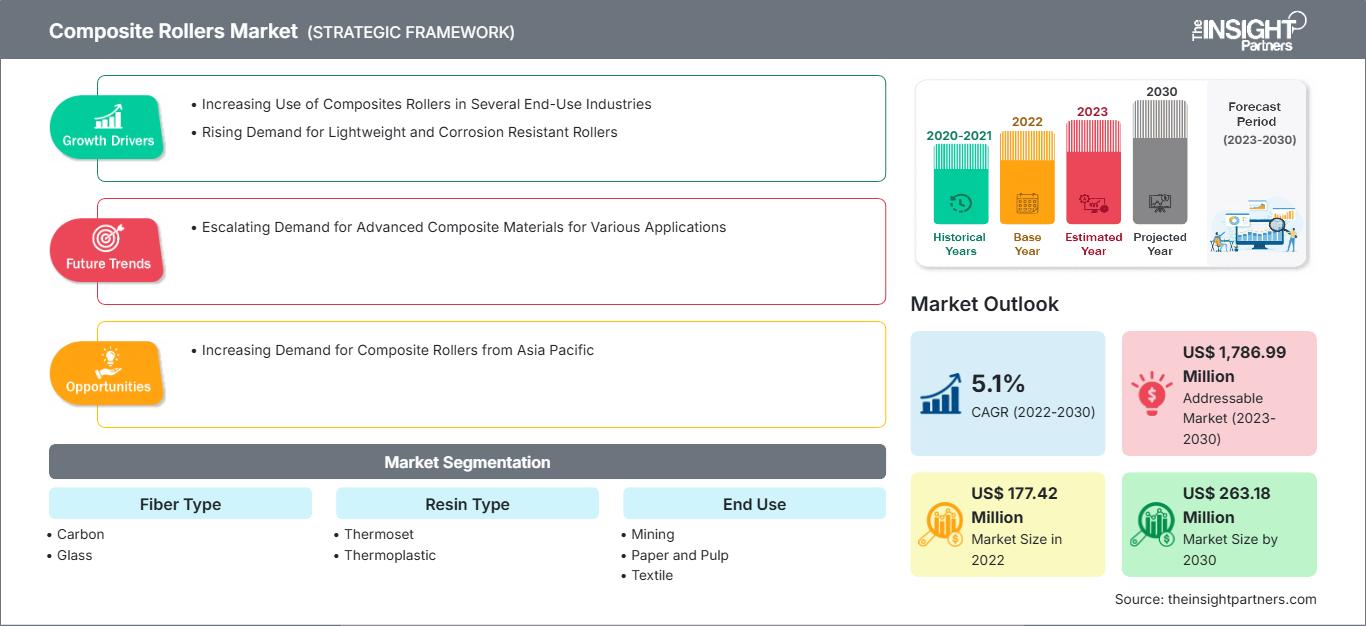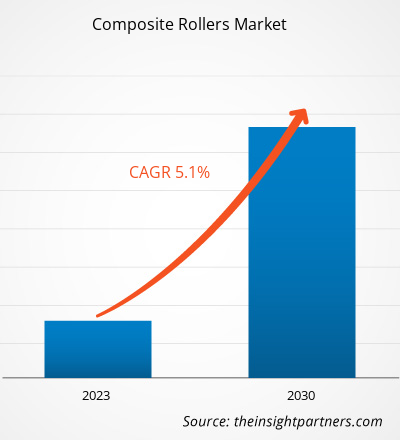[Informe de investigación] Se espera que el tamaño del mercado de rodillos compuestos crezca de US$ 177,42 millones en 2022 a US$ 263,18 millones en 2030; se estima que registrará una CAGR del 5,1% de 2022 a 2030.
Perspectivas del mercado y opinión de los analistas:
El mercado global de rodillos compuestos está experimentando un aumento significativo en la demanda debido a la creciente necesidad de materiales ligeros y duraderos en diversas industrias. Los rodillos compuestos se fabrican con materiales avanzados como fibra de carbono, fibra de vidrio y fibra de Kevlar, que ofrecen una alta relación resistencia-peso y resistencia a la corrosión y la abrasión. Se utilizan ampliamente en sistemas de transporte, máquinas de impresión, laminadoras y otras aplicaciones industriales para garantizar sistemas eficientes de manipulación y transporte de materiales. Se espera que la creciente atención a la sostenibilidad y la eficiencia energética impulse aún más la demanda de rodillos compuestos a nivel mundial.
Factores impulsores del crecimiento y desafíos:
Los rodillos compuestos se utilizan en diversas industrias, como la impresión, la textil, la minería y la pulpa y el papel. Estos rodillos se fabrican utilizando materias primas como fibras de carbono y vidrio, resinas y recubrimientos, mediante diferentes tecnologías. La constante evolución, principalmente en el caso de la maquinaria industrial, se asocia a su fácil manejo, menor consumo de energía y ligereza. Este panorama abre nuevas perspectivas para el uso de materiales compuestos en numerosos sectores industriales. Los rodillos compuestos se utilizan en áreas específicas de la minería, como la maquinaria pequeña y grande; por lo tanto, se espera que el aumento de las actividades mineras y de exploración impulse la demanda de estos rodillos, impulsando así el crecimiento del mercado de rodillos compuestos. El creciente uso de rodillos compuestos en la industria de la pulpa y el papel está impulsando el crecimiento del mercado global de rodillos compuestos. Los rodillos compuestos son ampliamente utilizados en la industria de la pulpa y el papel debido a su excelente resistencia, reducción de vibraciones y ruido, baja inercia y bajo consumo eléctrico. En la industria del papel y la pulpa, los rodillos compuestos se utilizan para aplicaciones como rodillos guía de papel, rodillos guía para pantallas o fieltros, rodillos para la sección de secado, rodillos de pecho agitado y rodillos guía de calandrado. Sin embargo, el factor que frena el crecimiento del mercado global de rodillos compuestos es la creciente preocupación ambiental por el reciclaje de compuestos de fibra de carbono y vidrio. El creciente uso de productos compuestos de fibra de carbono y vidrio ha aumentado la conciencia sobre la eliminación de residuos. El uso generalizado de materiales compuestos ha provocado un aumento masivo en la generación de basura. La creciente preocupación por reciclar estos residuos compuestos de forma rentable sin causar un impacto ambiental negativo está en aumento.
Obtendrá personalización en cualquier informe, sin cargo, incluidas partes de este informe o análisis a nivel de país, paquete de datos de Excel, así como también grandes ofertas y descuentos para empresas emergentes y universidades.
Mercado de rodillos compuestos: perspectivas estratégicas

- Obtenga las principales tendencias clave del mercado de este informe.Esta muestra GRATUITA incluirá análisis de datos, desde tendencias del mercado hasta estimaciones y pronósticos.
Segmentación y alcance del informe:
El mercado global de rodillos compuestos se segmenta según el tipo de fibra, el tipo de resina, el uso final y la ubicación geográfica. Según el tipo de fibra, el mercado de rodillos compuestos se divide en carbono, vidrio y otros. El segmento de carbono se divide a su vez en basado en PAN y basado en brea. El mercado de rodillos compuestos se segmenta según el tipo de resina en termoestable y termoplástico. El segmento de termoestable se divide a su vez en epoxi, poliuretano y otros. El segmento de termoplástico se divide a su vez en polietileno, polipropileno, cloruro de polivinilo y otros. El mercado de rodillos compuestos se segmenta según el uso final en minería, papel y pulpa, textiles, películas y láminas, impresión y otros. El mercado de rodillos compuestos, según la geografía, está segmentado en América del Norte (EE. UU., Canadá y México), Europa (Alemania, Francia, Italia, Reino Unido, Rusia y el resto de Europa), Asia Pacífico (Australia, China, Japón, India, Corea del Sur y el resto de Asia Pacífico), Medio Oriente y África (Sudáfrica, Arabia Saudita, Emiratos Árabes Unidos y el resto de Medio Oriente y África) y América del Sur y Central (Brasil, Argentina y el resto de América del Sur y Central).
Análisis segmentario:
Según el tipo de fibra, el mercado de rodillos compuestos se segmenta en carbono, vidrio y otros. El segmento de carbono tuvo una participación significativa en el mercado de rodillos compuestos y se espera que registre un crecimiento considerable durante el período de pronóstico. La fibra de carbono es una hebra larga y delgada de material compuesto por átomos de carbono. Estas fibras ofrecen alta resistencia a la tracción, tolerancia a altas temperaturas y durabilidad. Poseen mayor rigidez y resistencia, excelente resistencia a la corrosión y una vida útil más larga que otros materiales, como el aluminio y el acero. Por lo tanto, estas fibras tienen aplicaciones más amplias en diversas industrias. Son rígidas y químicamente inertes, lo que dificulta su compresión y estiramiento. Se utilizan en diversas industrias, como la minería, la industria textil, la pulpa y el papel, la industria aeroespacial y de defensa, la automoción y la construcción.
Análisis regional:
Según la geografía, el mercado de rodillos compuestos se divide en cinco regiones clave: América del Norte, Europa, Asia Pacífico, América del Sur y Central, y Oriente Medio y África. El mercado mundial de rodillos compuestos estuvo dominado por Asia Pacífico, que representó más de 80 millones de dólares estadounidenses en 2022. América del Norte es el segundo mayor contribuyente, con una previsión de más del 20% de la cuota de mercado mundial de rodillos compuestos en 2028. Se prevé que Europa registre una tasa de crecimiento significativa superior al 4% entre 2022 y 2030. El mercado europeo de rodillos compuestos está segmentado en Alemania, Francia, Italia, Reino Unido, Rusia y el resto de Europa. Países como el Reino Unido, Alemania y Rusia han experimentado un crecimiento significativo en la implementación de soluciones tecnológicamente avanzadas. La minería, el textil y la pulpa y el papel se encuentran entre las industrias que prosperan en la región y que, en consecuencia, impulsan el crecimiento del mercado de rodillos compuestos. En el caso de las actividades mineras, Rusia ocupa una posición destacada a nivel mundial, y en la industria minera, estos rodillos compuestos están ganando popularidad. La industria textil también contribuye en gran medida a la creciente demanda de rodillos compuestos en Europa.
Desarrollos de la industria y oportunidades futuras:
A continuación se enumeran diversas iniciativas adoptadas por los actores clave que operan en el mercado de rodillos compuestos:
- En 2023, Rulmeca presentó el nuevo rodillo compuesto Rulmeca. Este nuevo producto es un rodillo no metálico diseñado para transportadores de manipulación de materiales a granel.
- En 2021, Pronexos lanzó una nueva gama de recubrimientos compuestos resistentes al desgaste, Tonex, que ofrecerá a los clientes nuevas opciones rentables para aplicaciones de rodillos de plástico reforzado con fibra de carbono (CFRP).
- En 2021, Pronexos produjo rodillos de fibra de carbono muy largos para teatros de cruceros.
- En 2023, EPSILON Composite, un fabricante de rodillos de fibra de carbono, se asoció con Packone Solutions para la promoción y distribución de sus productos en India, Sri Lanka, Nepal y Bangladesh.
- En 2022, Double E Company LLC adquirió Daven Manufacturing LLC. Con esta adquisición, Double E Company LLC planea ampliar su alcance a la producción de pisos, continuando su misión de ofrecer soluciones de productividad y seguridad que resuelvan los desafíos operativos en toda la industria de la conversión.
Perspectivas regionales del mercado de rodillos compuestos
Los analistas de The Insight Partners han explicado detalladamente las tendencias regionales y los factores que influyen en el mercado de rodillos compuestos durante el período de pronóstico. Esta sección también analiza los segmentos y la geografía del mercado de rodillos compuestos en América del Norte, Europa, Asia Pacífico, Oriente Medio y África, y América del Sur y Central.
Alcance del informe de mercado de rodillos compuestos
| Atributo del informe | Detalles |
|---|---|
| Tamaño del mercado en 2022 | US$ 177,42 millones |
| Tamaño del mercado en 2030 | US$ 263,18 millones |
| CAGR global (2022-2030) | 5,1% |
| Datos históricos | 2020-2021 |
| Período de pronóstico | 2023-2030 |
| Segmentos cubiertos | Por tipo de fibra
|
| Regiones y países cubiertos | América del norte
|
| Líderes del mercado y perfiles de empresas clave |
|
Densidad de actores del mercado de rodillos compuestos: comprensión de su impacto en la dinámica empresarial
El mercado de rodillos compuestos está creciendo rápidamente, impulsado por la creciente demanda del usuario final debido a factores como la evolución de las preferencias del consumidor, los avances tecnológicos y un mayor conocimiento de los beneficios del producto. A medida que aumenta la demanda, las empresas amplían su oferta, innovan para satisfacer las necesidades del consumidor y aprovechan las tendencias emergentes, lo que impulsa aún más el crecimiento del mercado.

- Obtenga una descripción general de los principales actores clave del mercado de rodillos compuestos
Impacto del COVID-19:
La pandemia de COVID-19 afectó a casi todas las industrias en varios países. Los confinamientos, las restricciones de viaje y el cierre de empresas en América del Norte, Europa, Asia Pacífico (APAC), América del Sur y Central (SAM) y Oriente Medio y África (MEA) obstaculizaron el crecimiento de varias industrias, incluida la industria química y de materiales. El cierre de las unidades de fabricación de las empresas de rodillos compuestos alteró las cadenas de suministro globales, las actividades de fabricación y los plazos de entrega. Varias empresas experimentaron retrasos en las entregas de productos y una caída en las ventas en 2020.
Varias industrias están mejorando su situación a medida que las limitaciones de suministro que las afectan se resuelven gradualmente. Además, la creciente demanda de rodillos compuestos en las industrias de películas y láminas, impresión, textiles y minería está impulsando considerablemente el crecimiento del mercado de rodillos compuestos.
Panorama competitivo y empresas clave:
Dongguan Precision Converting Transmission Co. Ltd., Pronexos BV, Composite Conveyor Equipment Co., Carbon Light Pvt. Ltd., PROK Pty. Ltd., ADENTE Advanced Engineering Technologies, Lorbrand (Pty.) Ltd., Double E Co. LLC, HAHL GmbH y Rossini Sp. A. se encuentran entre las pocas empresas que operan en el mercado global de rodillos compuestos. Estas empresas se centran en ofrecer productos de alta calidad para satisfacer la demanda de los clientes.
- Análisis histórico (2 años), año base, pronóstico (7 años) con CAGR
- Análisis PEST y FODA
- Tamaño del mercado, valor/volumen: global, regional y nacional
- Industria y panorama competitivo
- Conjunto de datos de Excel
Informes recientes
Testimonios
Razón para comprar
- Toma de decisiones informada
- Comprensión de la dinámica del mercado
- Análisis competitivo
- Información sobre clientes
- Pronósticos del mercado
- Mitigación de riesgos
- Planificación estratégica
- Justificación de la inversión
- Identificación de mercados emergentes
- Mejora de las estrategias de marketing
- Impulso de la eficiencia operativa
- Alineación con las tendencias regulatorias






















 Obtenga una muestra gratuita para - Mercado de rodillos compuestos
Obtenga una muestra gratuita para - Mercado de rodillos compuestos